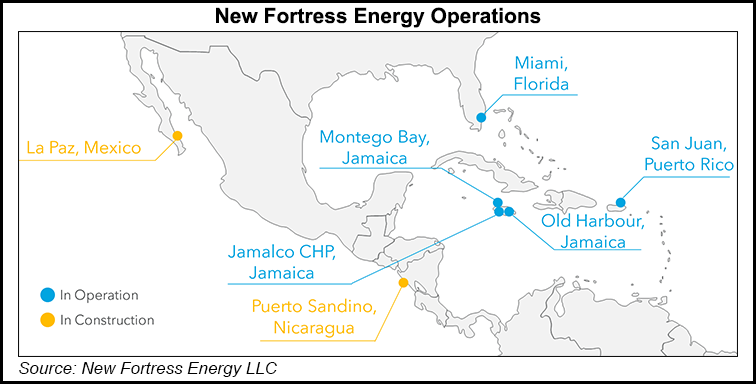LNG | Infrastructure | LNG Insight | NGI All News Access | NGI The Weekly Gas Market Report | Regulatory
New Fortress Rejects FERC Claim Puerto Rico LNG Terminal Unauthorized
New Fortress Energy LLC has asked FERC to end proceedings about whether a liquefied natural gas (LNG) import terminal in Puerto Rico was brought online without federal approval, while a key end-user does not want it shut down.

NFE said the facility is not subject to Federal Energy Regulatory Commission jurisdiction under the Natural Gas Act (NGA). The company also noted that FERC staff said the terminal did not require Commission approval after repeated discussions.
Other entities, including the U.S. Coast Guard, consulted with FERC staff during a regulatory review that began in 2017, NFE said, and the Commission did not invoke its authority under the NGA during those discussions.
FERC ordered NFE last month to explain why it built the terminal without federal approval. The facility was commissioned in April and supplies gas-fired generation units by pipeline, as well as supply to industrial users and microgrids via trucks.
In response to the order, the Puerto Rico Electric Power Authority (PREPA) urged FERC not to halt operations. PREPA said it relies on the handling facility to provide LNG for two gas-fired generating units in the heart of the San Juan metropolitan area, the unincorporated territory’s largest load center. If operations were disrupted, wrote CEO José F. Ortiz Vázquez, it would likely mean the dual-fuel units would need to burn diesel, limiting the ability to curb emissions and reduce costs.
The case is a rare one. FERC said in its order it has authority over the siting, construction, expansion or operation of LNG terminals and said it previously approved similar facilities in Puerto Rico. It is the lead federal agency for approving LNG terminals and cooperates with other state and federal agencies during the permitting process. The U.S. Coast Guard and the Pipeline and Hazardous Materials Safety Administration, among other entities, also are involved in regulating facilities.
However, of the 110 LNG facilities operating in the United States, FERC has jurisdiction over only 24. NFE argued in its response to the show cause order that FERC-jurisdictional facilities are different because they are served by LNG vessels, with large storage tanks on site, and they use interstate pipelines.
San Juan Harbor had an existing facility, and NFE added capability to take delivery of LNG from smaller vessels. The PREPA facility is also served by a 75-foot pipeline, which NFE noted is smaller than others used by facilities over which FERC has waived jurisdiction in the past.
The facility configuration that “NFE ultimately proposed made it like other LNG facilities which the Commission had concluded did not require its authorization under the Natural Gas Act,” Ortiz Vázquez added.
[Want to know how global LNG demand impacts North American fundamentals? To find out, subscribe to LNG Insight.]
PREPA signed a deal with NFE last year to convert two of generating units to dual-fuel capabilities and to supply them with up to 863,000 gallons/day of LNG. The agreement obligates NFE to transport LNG to San Juan Harbor, where it is transferred to a floating storage vessel docked opposite the San Juan Power Station.
The power authority has projected that its delivered fuel costs would decrease with the ability to consume gas, even as NFE must pay more to procure supply from outside the United States, given the prohibition on bulk shipments from mainland under the Jones Act.
How the case proceeds is unclear. FERC has no statutory timeline to respond, prompting NFE to request the matter be expedited. FERC could find the facility is in violation and shut it down. That is an unlikely outcome as similar cases have not resulted in suspension of operations, Ortiz Vázquez noted in a letter to the Commission. If FERC were to decide it has jurisdiction, proceedings could advance to determine whether to authorize the facility.
© 2024 Natural Gas Intelligence. All rights reserved.
ISSN © 1532-1231 | ISSN © 2577-9877 | ISSN © 1532-1266 |


